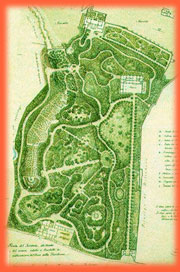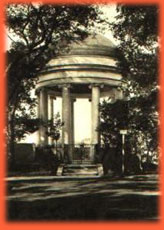|
 Once
crossed the huge gate, you enter the large Floridiana
park; it is divided in winding paths; there are
cypress-trees, pine-trees, holm oaks,citron-trees,
plane-trees and blooming cammelias. Once
crossed the huge gate, you enter the large Floridiana
park; it is divided in winding paths; there are
cypress-trees, pine-trees, holm oaks,citron-trees,
plane-trees and blooming cammelias.
Turning left in the middle of the main path, you
go up to the pretty open Theater. Going down in
the path you will see the villa; on the building
back you will find an esplanade; from the left
terrace you can admire an enchanting view of Naples,
its Gulf, the island of Capri. The small fountain
brightens the esplanade.
The villa Floridiana was made by Antonio Piccolini
between 1817 and 1819 according to the will of
king Ferdinando I who gave it as a present to
his morganatic wife Lucia Migliaccio Partanna,
duchess of Floridia.
The style of this building is from the neoclassical
Pompeii period; it is the seat of the Ceramics
Museum "Duca di Martina". This museum
has first of all a rich collection of ceramics,
but also of majolicas from the best European factories,
from Chine and Japan.  There
is also a collection of minor arts. In the second
half of Nineteenth century this collection was
started by don Placido di Sangro, duca di Martina.
He was a lover of "applied arts" and
after a stay in Paris he came back to Naples.
He was among those who revalued the minor arts,
rediscovered after the huge universal exhibitions
organized in the second half of Nineteenth century. There
is also a collection of minor arts. In the second
half of Nineteenth century this collection was
started by don Placido di Sangro, duca di Martina.
He was a lover of "applied arts" and
after a stay in Paris he came back to Naples.
He was among those who revalued the minor arts,
rediscovered after the huge universal exhibitions
organized in the second half of Nineteenth century.
Don Placido di Sangro collected in his villa valuable
and different works representing almost all the
minor arts: corals, enamels, avories, leather
goods, glasses, bronzes, snuff-boxes and many
ceramics and majolicas.
His nephew Placido di Sangro, earl de Marzi, donated
the collection to the city; the Museo del Duca
di Martina belongs to Naples from 1911 and the
Floridiana park was aquired in 1919 by the Italian
State. The State wanted the villa to become the
permanent seat of the ceramics collection in the
20ies.
|




 Once
crossed the huge gate, you enter the large Floridiana
park; it is divided in winding paths; there are
cypress-trees, pine-trees, holm oaks,citron-trees,
plane-trees and blooming cammelias.
Once
crossed the huge gate, you enter the large Floridiana
park; it is divided in winding paths; there are
cypress-trees, pine-trees, holm oaks,citron-trees,
plane-trees and blooming cammelias. There
is also a collection of minor arts. In the second
half of Nineteenth century this collection was
started by don Placido di Sangro, duca di Martina.
He was a lover of "applied arts" and
after a stay in Paris he came back to Naples.
He was among those who revalued the minor arts,
rediscovered after the huge universal exhibitions
organized in the second half of Nineteenth century.
There
is also a collection of minor arts. In the second
half of Nineteenth century this collection was
started by don Placido di Sangro, duca di Martina.
He was a lover of "applied arts" and
after a stay in Paris he came back to Naples.
He was among those who revalued the minor arts,
rediscovered after the huge universal exhibitions
organized in the second half of Nineteenth century.